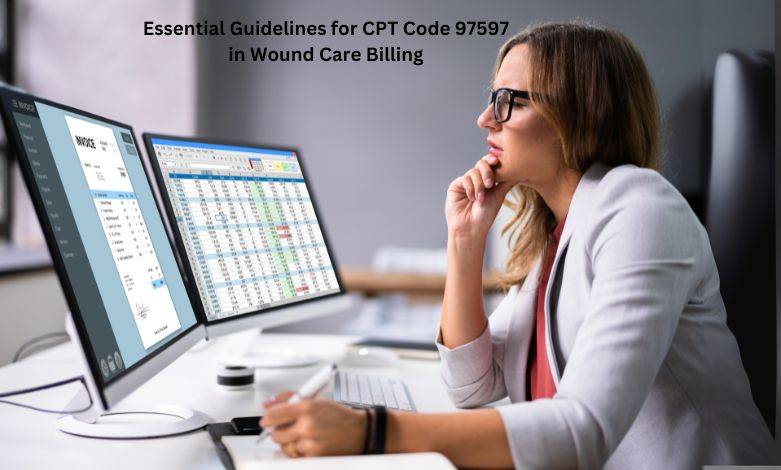CPT code 97597:
Correct and reliable coding has an important impression on proper documentation, billing, and reimbursement in the medical field. With these, CPT code 97597 is important for wound care supervision. To record the debridement of open wounds, the CPT code 97597 is utilized. Debridement procedures comprise high-pressure water jet with or without pressure, sharp selective debridement with scissors, blade, and forceps; open wound methods include fibrin, devitalized epidermis and dermis, exudation, debris, and biofilm; topical application(s); wound evaluation; use of a whirlpool when needed; and directions for continuous care. The total external area of the wound(s) is restricted to the first 20 square centimeters.
Proper Coding for CPT Code 97597:
Several fundamental issues should be taken into account while coding for wound debridement with CPT code 97597:
Time-based coding: 97597 is a time-based CPT code that characterizes a single wound debridement meeting. It doesn’t take into deliberation how long the procedure will take. The service time should be well-known by providers in the patient’s file.
Limitations on wound size: Keep in mind that wounds having a surface area of 20 square centimeters or less are covered under CPT code 97597. A separate code, such as 97598 for every further 20 square centimeters, should be given if the wound is larger than this.
Document accuracy: For billing and coding purposes, precise and thorough documentation is essential to ensure accuracy and compliance. Verify that the documentation clearly explains the use of CPT code 97597, emphasizing the debridement procedure’s medical necessity. Accurate documentation not only supports proper claim submission but also aids in minimizing denials and optimizing reimbursement. Effective Medical Billing Services can help ensure that the documentation aligns with payer requirements, improving the overall revenue cycle.
Medical necessity: The basis for debt relief should be medical necessity. The description for debridement, such as the occurrence of necrosis, nonviable tissue, or symptoms of infection in the wound, as well as the expected benefits of debridement in speeding up wound healing, must be entered in the documentation.
The procedure’s uniqueness: Although CPT code 97597 includes a range of debridement techniques, it is crucial to detail the instruments and techniques utilized in each treatment precisely. This data facilitates appropriate classification and helps paint a clear picture of the services rendered.
Requirements for Use and Documentation of CPT Code 97597:
When dynamic debridement is needed for a wound, CPT code 97597 is typically used. Debridement is the process used to remove infections, unrelated substances, or nonviable tissue from a wound to help cure. The code covers the use of forceps, scissors, scalpels, and high-pressure waterjet debridement among other debridement tools. For healthcare professionals to correctly report CPT code 97597, they need to record the following data:
Wound assessment: A detailed evaluation of the wound, including its size, location, stage, and any related consequences or comorbidities, should be included in the documentation.
Debridement method: Show the form of debridement that was used. Such as a mix of techniques, a high-pressure water jet, or acute selective debridement. Document the aggregate of debridement as well as the different tissue types that were eliminated, such as fibrin, devitalized epidermis/dermis, debris, biofilm, etc.
Topical application: Express the correct substances consumed if any bandages or topical treatments are used following debridement.
The surface area of the wound: Measure and note the wound’s surface area, making sure it goes through the code’s constraints by being no more than 20 square centimeters.
Use instructions for Whirlpools and endless maintenance: Include information in the paperwork if a whirlpool is used during the session or if instructions are given for continued care.
Types of wounds and Treatments Included in CPT 97597:
This CPT addresses the selective debridement of wounds that are infected, such as burns, acute (such as traumatic and surgical wounds), and chronic (such as diabetic and pressure ulcers).
Types of wounds covered by CPT code 97597:
Chronic wounds:
Pressure ulcers: So, The skin injury affected by endless pressure is known as a pressure ulcer.
Diabetic ulcers: Diabetic ulcers are non-healing scratches that are commonly viewed on diabetics’ feet.
Vascular Stasis Ulcers: These ulcers, which typically look in the legs, are affected by insufficient blood flow.
Acute wounds:
Traumatic Wounds: Accident-related wounds such cuts, abrasions, and lacerations.
Surgical Wounds: Wounds from surgery that want to be debrided to acquire relief of necrotic tissue.
Infected wounds:
Contaminated Wounds: Infected wounds showing symptoms of the disease need debridement to remove unclean tissue and smooth the progress of recovery.
Burns: Burns that are somewhat thick, requiring debridement to get rid of dead skin and stop an infection.
Conclusion:
Active wound care medication needs the understanding of and observance of CPT Code 97597 for targeted skin and tissue debridement up to 20 sq cm. Severe devotion to billing regulations, general documentation, and accurate coding is essential for the highest reimbursement and compliance. Medical professionals can improve patient results, reduce billing mistakes, and boost compliance by sticking to best practices. One of the top wound care billing companies. The Medicators, is recognized for its expertise and expertise in handling the complex billing and coding requirements of wound care services. The Medicators increase reimbursement for wound care providers by ensuring accuracy. Moreover, timely claim submission over a staff of highly qualified and certified medical billers and coders.









